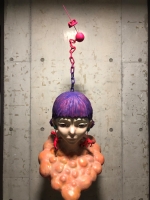“HU Student Interview Series” gives our prospective students an insight into the perspectives of HU students. On the 45th interview in this series, we talked to Mr. Ichita Yamazaki, who graduated from Kobe Ryukoku Senior High School in Hyogo Prefecture. He is currently a 4th-year student studying at the School of Education Cluster 4 (Life-long Activities Education) Program in Art Education.
We first came to know Mr. Yamazaki at an exhibition of his work at Hiroshima University. Sensing something unique in his sculptures, we asked to interview him but was surprised when he told us that he was not engaged in art until he entered university. Why did he, a karate kid, step into the world of art? It was because he was motivated by his clear vision.
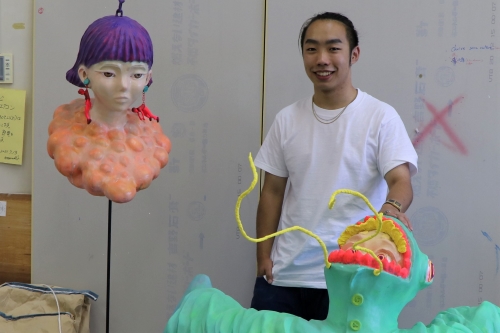
What made you decide to apply to Hiroshima University?
I had a strong desire to be engaged in the field of education, but the university I initially wanted to attend did not allow me to specialize in pedagogy even though I could obtain a teaching license. So, I reconsidered my future and decided to apply to Hiroshima University, which is famous in western Japan for its School of Education, where I can specialize in pedagogy.
Why did you decide to apply to the current course? Did you like art?
No. I had been doing karate at a local dojo since I was six and had nothing to do with art. I wanted to go to the School of Education to become a teacher but hadn't decided on a subject. After the National Center Test for University Admissions was over, I thought about what kind of teacher I wanted to be and chose art because it seemed exciting and rewarding.
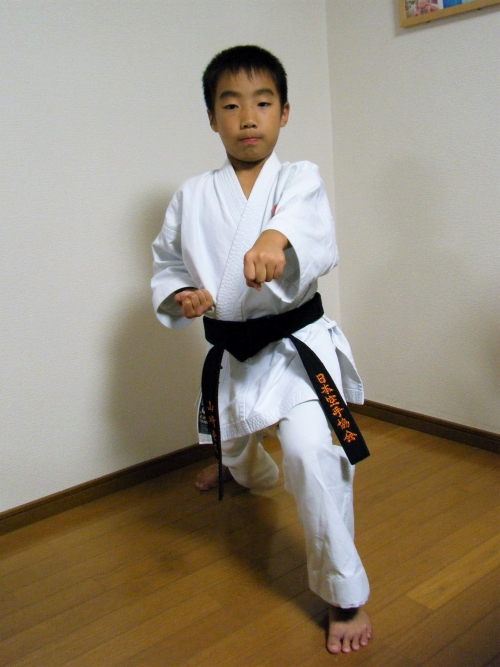
Mr. Yamazaki continued Karate from Age 6 up until High School Graduation
The exam format is special in art, so wasn't it hard to prepare?
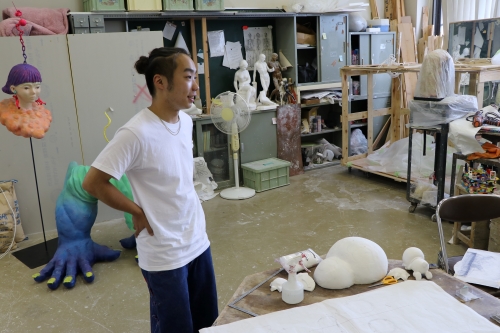
We interviewed him at his university studio.
I had been studying intending to take the entrance examinations for national universities, but since I decided to take the art course after the National Center Test, I had to learn plaster sketching, which was one of the required subjects for the examination, at a very fast pace. To prepare for the entrance exam, I applied to a local art school (a private art school run voluntarily by painters) and spent 8 to 10 hours every day for a little less than a month to thoroughly study drawing. I was a beginner when it came to sketching, so I was shocked to see the difference between my first plaster sketch and the real thing, but I didn't have much time, so I just pushed on and worked hard to acquire the skill. I took the general entrance exam (first-semester schedule), so there was no interview or essay.
How did you come to choose to pursue sculpting?
In my first and second years, I studied a wide range of basic art subjects, including design, painting, crafts, and art education, and in my third year, I chose sculpture from among painting, design, crafts, and sculpture. When I was a first-year student, I received compliments on my first practical work in sculpture, and hoping against hope, I decided to pursue it, but now that I think about it, I have realized that it suited me because I could directly express my theme of “human relationships.” In 2021, I entered my work in the 33rd Higashi-Hiroshima City Art Exhibition and won the “Opening Memorial Special Prize,” which gave me even more confidence. I am now working on my graduation thesis and preparing for my graduation exhibition by researching several artists who share similar sensibilities with me and comparing their works with my own.
What were the positive things about enrolling at Hiroshima University?
What was good about coming to Hiroshima University was that even though I had no basic knowledge of art, the teachers did not treat me like a beginner but respected me as an individual student and helped me to learn and develop. It’s embarrassing to say this, but I think I was lucky to have such good teachers. The teachers took it as a good thing that I didn’t know anything, and instructed me based on the notion of “what can I do now?” They respected me in everything and guided me in the right direction with precise support.
Please tell us about your student life.
I served as the representative for the university’s art exhibition, and I was responsible for handling practical matters, such as arranging venues, travel expenses, and handling the publicity for the event. I was also the representative of a designing society called “Atrico” which creates posters and videos. I am now retired, having been succeeded by a younger student, but in that connection, I am participating as an exhibition designer in the “Art Garden of Light Project,” to create a giant balloon art in the plaza in front of the Higashi-Hiroshima Museum in cooperation with the Junior Chamber of Commerce. It will be unveiled along with the illumination around November 19, 2021.
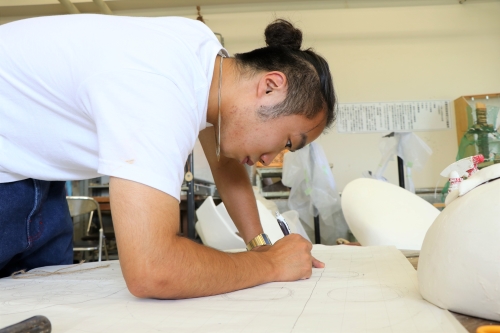
Developing the Exhibition design plans for the "Art Garden of Light Project"
Weekday schedule with classes
| 8 a.m. | Wake up |
| 9 a.m. | Breakfast |
| 10 a.m.~5 p.m. | Class |
| 6 p.m. | Dinner |
| 7 p.m.~9 p.m. | Watch a movie, etc. |
| 9 p.m.~10:30 p.m. | Work-out, Jogging |
| 11 p.m.~ | Preparation for class, etc. |
| 1:30 a.m. | Going to bed |
I used to have part-time jobs in restaurants and event set-up services, but I don't do much of that anymore. Nowadays, I am focused on preparing for my graduation exhibition, thesis, and my future career.
What are your thoughts on the university's support and welfare provisions?
I feel that the university is very supportive. I took English conversation classes for a year in another department and studied abroad in Australia for ten days for cultural exchange. I am grateful to the university for providing us with a place where we can learn what we want to learn. If my computer breaks down, I can take it to the Co-op store on campus, and they will fix it, and if I drop my student ID card, someone will make sure it gets back to me. I also use a meal card, which is a yearly cafeteria pass, so I can eat without having to cook for myself in the school cafeteria.
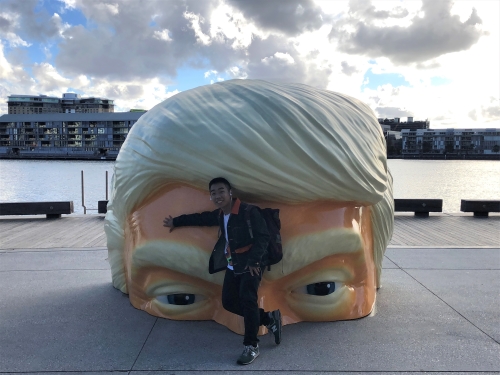
In Sydney during the English Communication Course of the Sydney Intercultural Experience Program
What are your goals and dreams for the future?
I want to become a teacher who respects the diversity of each individual and can support even minority students. I hope that by becoming the kind of teacher I want to be, I can contribute to making the education community a better place. I am currently in my fourth year of study, so I am preparing to go to graduate school to achieve my ideal vision of a teacher.
Finally, please give a message to younger students who are thinking about enrolling at Hiroshima University!
Even if you are unsure of yourself and think your ideas are poor, Hiroshima University will accept them and give you full support. So please don't keep your opinions to yourself, and go for it!
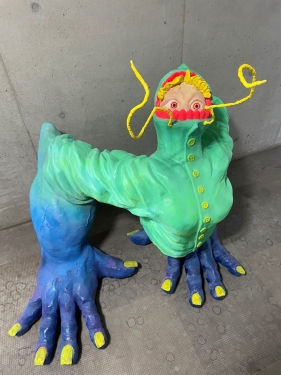
べった relations (betta relations)
Work chosen for the 2021 Hiroshima Prefecture Web Public Art Exhibition
October, 2021
Interview and Photograph: Public Relations Group (M)
Location: Sculpture Room, Art Building, School of Education


 Home
Home